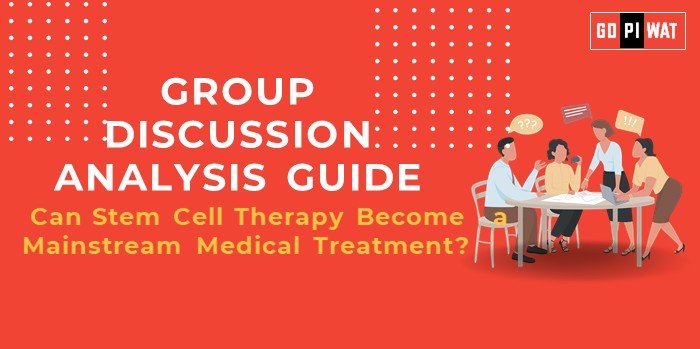📋 Group Discussion (GD) Analysis Guide: Can Stem Cell Therapy Become a Mainstream Medical Treatment?
🌐 Introduction
Stem cell therapy has emerged as a beacon of hope in modern medicine, with the potential to revolutionize treatments for chronic and terminal illnesses. However, challenges such as ethical concerns, regulatory complexities, and high costs impede its mainstream adoption.
📊 Quick Facts & Key Statistics
• Global Market Size: Valued at USD 456 million in 2024; projected CAGR of 25.23% (2025–2030).
• Regulatory Approvals: U.S. FDA approved Omisirge in April 2024, advancing treatment for hematologic malignancies.
• Clinical Trials: 90 registered trials involving human pluripotent stem cells across 13 countries by 2021.
• Economic Barrier: Therapies like joint injections can cost up to USD 16,500, limiting accessibility.
• Regulatory Approvals: U.S. FDA approved Omisirge in April 2024, advancing treatment for hematologic malignancies.
• Clinical Trials: 90 registered trials involving human pluripotent stem cells across 13 countries by 2021.
• Economic Barrier: Therapies like joint injections can cost up to USD 16,500, limiting accessibility.
🌟 Stakeholders and Their Roles
- 🏛️ Government Agencies: Establish regulations, fund research, and set ethical standards.
- 💊 Pharmaceutical Companies: Innovate therapies, expand manufacturing capabilities.
- 📚 Academic and Research Institutions: Drive clinical trials and technological advancements.
- 🤝 Patients and Advocacy Groups: Advocate for affordability and inclusivity in treatment.
🏆 Achievements and Challenges
📌 Achievements:
- ✅ FDA approval of transformative treatments like Omisirge demonstrates progress.
- ✅ Increasing global clinical trial registrations signal expanding research.
- ✅ Milestones in treating hematologic and autoimmune diseases.
📌 Challenges:
- ⚠️ High Costs: Pricing limits access, as seen with joint injection costs up to USD 16,500.
- ⚠️ Ethical Concerns: Use of embryonic stem cells continues to be debated.
- ⚠️ Regulatory Complexity: Global disparities in approval processes hinder universal adoption.
🎯 Effective Discussion Approaches
- Opening Approaches:
- “Stem cell therapy, with its USD 456 million market in 2024, symbolizes a revolution in medicine but faces obstacles to becoming mainstream.”
- “The FDA’s recent approval of Omisirge highlights breakthroughs in hematologic treatments but underscores economic and ethical barriers.”
- Counter-Argument Handling:
- Highlight alternatives like induced pluripotent stem cells (iPSCs), which bypass ethical controversies.
- Address cost issues by emphasizing technological advancements reducing therapy costs.
📈 Strategic Analysis of Strengths & Weaknesses
- Strengths: Unprecedented potential for curing chronic illnesses; growing clinical trial activity.
- Weaknesses: High costs and ethical concerns limit acceptance.
- Opportunities: Accelerated research, emerging technologies like iPSCs.
- Threats: Regulatory delays, unequal global access.
🗣️ Structured Arguments for Discussion
- 👍 Supporting Stance: “Stem cell therapy is unlocking cures for diseases previously deemed untreatable.”
- 👎 Opposing Stance: “Exorbitant costs and ethical issues hinder stem cell therapy’s mainstream adoption.”
- ⚖️ Balanced Perspective: “While stem cell therapy is promising, affordability and global standards are crucial for adoption.”
🎓 Connecting with B-School Applications
- 📌 Real-World Applications:
- Research and development in healthcare companies.
- Policy-making for equitable healthcare solutions.
- ❓ Sample Questions:
- “What strategies can reduce the economic barriers to stem cell therapies?”
- “How do global regulations affect stem cell therapy adoption?”
- 💡 Insights for B-School Students: Focus on healthcare management and ethical governance.


